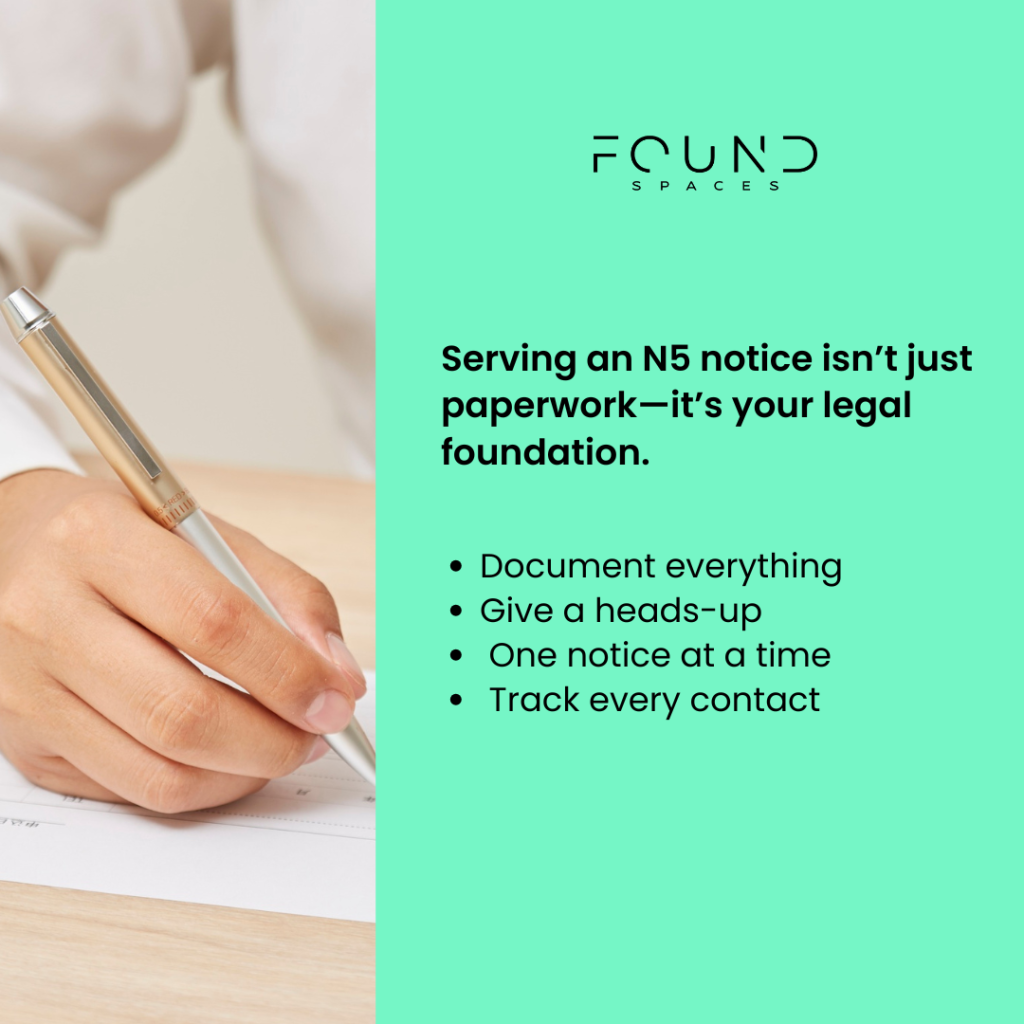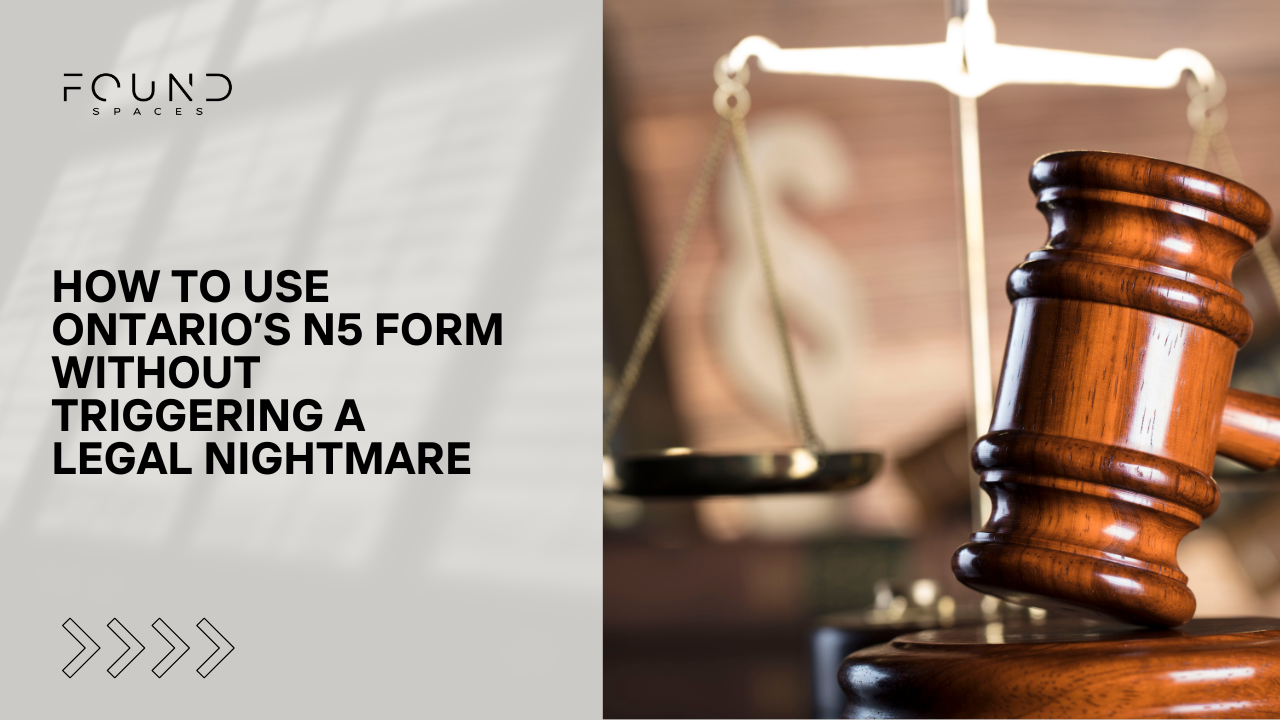Managing tenant issues using Ontario’s N5 form can be challenging if you’re not careful. The N5 is a formal notice used when tenants cause problems like damaging property or disturbing others. To avoid legal trouble, it’s important to be clear and specific about the issue, include an exact termination date, and follow timing rules closely, tenants have 7 days to fix the problem or the notice stands.
Document everything carefully and try talking with your tenant first before sending an N5. Also, don’t rush with multiple notices for the same problem, as that could hurt your case. When in doubt, seek professional help to handle it right without extra hassle.
What Is Ontario’s N5 Form and When to Use It

Ontario’s N5 Form is a formal notice landlords use to address specific tenant issues such as disturbing others, damaging the rental unit beyond normal wear and tear, or exceeding occupancy limits. It applies when a tenant’s behavior disrupts neighbors or the landlord, causes property damage, or violates lease or local occupancy rules.
The N5 serves as a warning, giving tenants 7 days to correct the problem. If resolved within this period, the notice is void and the tenancy continues. If not, the notice sets a termination date, allowing the landlord to seek eviction.
Proper service of the N5 is essential to its legal validity. Importantly, this form is not used for non-payment of rent, which requires a different notice. When used correctly, the N5 helps landlords address problematic behavior while respecting tenant rights and avoiding legal complications.
Common Tenant Issues Addressed by the N5 Form
The N5 Form is used by landlords in Ontario to address a wide range of tenant behaviors that disrupt the rental environment or violate lease terms. Common issues include:
- Noise disturbances such as loud parties or frequent late-night disruptions that bother neighbors or other tenants.
- Damage to the unit or common areas, including broken windows, holes in walls, or other harm beyond normal wear and tear.
- Overcrowding due to unauthorized occupants, which may breach lease agreements and fire codes.
- Repeated disruptive or aggressive behavior, including yelling, threats, or intimidation that impacts the safety and comfort of others.
- Illegal activities on the premises, such as drug use or distribution.
- Health hazards caused by poor hygiene, hoarding, or failure to manage pests.
- Lease violations, like running a business from the rental unit without permission.
- Unauthorized modifications, such as painting or making structural changes without consent.
- Harassment or intimidation of other tenants or the landlord.
- Pet-related issues, including animals that cause damage or excessive noise.
Clearly stating the specific issue on the N5 notice gives the tenant a chance to correct the problem within 7 days. If resolved, the notice becomes void and tenancy continues. If not, the landlord can proceed with termination steps.
How to Fill Out the N5 Form Correctly
- Get the Official Form
Download the latest N5 from the Landlord and Tenant Board website to ensure you have the correct version. - Identify the Parties and Property
Enter the tenant’s full name and the complete rental address clearly and accurately. - Describe the Breach Precisely
State the specific conduct (e.g. “On March 5, tenant damaged the kitchen door”) and reference any supporting evidence (photos, emails). - Set Compliance and Termination Dates
- Compliance Deadline: 7 days from receipt of the notice.
- Termination Date: At least 14 days after receipt, if the breach is not remedied.
- Sign and Provide Contact Information
Sign (or have your authorized agent sign), date the form, and include your contact details. - Keep It Professional
Avoid extra demands, vague language, or threats beyond what the form permits. Proofread for spelling and grammar. - Document and Serve
Make and retain copies of the completed form before serving it in accordance with LTB guidelines.
Steps to Serve an N5 Notice Without Mistakes

- Verify Tenant Details
Confirm the tenant’s current address and contact information. - Deliver the Notice
- Personal Delivery: Hand the N5 directly to the tenant and note the date and time.
- Alternative Delivery: If personal service isn’t possible, post it in a conspicuous place (e.g., door or mailbox) and send a copy by registered mail.
- Document Service
Retain a copy of the notice plus delivery receipts or tracking details. - Pre‑Notice Communication
Whenever possible, warn the tenant verbally or in writing before issuing the formal notice to encourage compliance. - Avoid Duplicate Notices
Don’t issue multiple N5s for the same breach in quick succession—this can invalidate your case. - Track All Contacts
Record every attempt to discuss the issue with the tenant to show reasonable efforts at resolution.
How the Tenant Can Void an N5 Notice
- Correct the Breach: The tenant has 7 days from receipt to fix the problem (e.g., stop the disruptive behavior or repair damage).
- Automatic Void: Once fully remedied, the N5 becomes void—no eviction proceedings may follow based on that notice.
- Document the Fix: Tenants should provide proof (photos, receipts) to avoid disputes, though written confirmation isn’t strictly required.
- Alternate Option: A tenant may also end the tenancy by giving 10 days’** written notice after receiving the N5.
- Dispute Rights: If the tenant believes the notice is unjust, they can file a response with the Landlord and Tenant Board.
What to Do If the Tenant Does Not Fix the Problem
- Wait for the 7‑Day Period to Expire
Do not file for eviction until after the compliance deadline passes. - File an L2 Application
Submit an eviction application to the Landlord and Tenant Board, attaching:- The original N5 notice
- Proof of service
- Documentation showing the tenant did not comply
- Prepare Your Case
Bring to the hearing: photos, witness statements, communication logs, and any other relevant evidence. - Maintain Professionalism
Avoid “self-help” evictions (e.g., changing locks) and consider mediation if appropriate. - Consult Experts
If you’re uncertain about procedures or paperwork, seek advice from a legal professional or property manager.
Documenting Problems: Why Details Matter
- Log Incidents: Note dates, times, locations, and objective descriptions of each breach.
- Capture Evidence: Take clear photos or videos of damage or hazards.
- Archive Communications: Save emails, texts, letters, and records of verbal warnings.
- Collect Witness Statements: Obtain written accounts from neighbors or other tenants.
- Record Tenant Responses: Document any repairs or corrective actions the tenant makes.
- Organize Securely: Store all records in a well‑organized file for quick retrieval at the Landlord and Tenant Board.
Thorough, objective documentation strengthens your case and can expedite resolution without unnecessary legal escalation.
Timing Rules to Follow When Using the N5

Timing is critical when using Ontario’s N5 form. Tenants have exactly 7 days from the date they receive the notice to correct the issue. If they do so within this period, the notice is void and eviction cannot proceed. The termination date listed must be at least 14 days after service to provide adequate time for the tenant to respond or vacate.
Accurately track the delivery date, as miscalculations can result in the Landlord and Tenant Board dismissing your case. If the issue is not resolved after 7 days, you may file an L2 application to request eviction. However, if the tenant corrects the problem, avoid immediately serving a new N5 for the same issue—doing so too soon can lead to dismissal.
Tenants also have the option to give 10 days’ written notice to end the tenancy after receiving an N5. Clearly state all relevant dates on the notice to prevent confusion. Following these timing rules ensures your notice remains valid and strengthens your eviction case.
How to Avoid Serving Multiple N5 Notices Too Soon
Avoid issuing back-to-back N5 notices without giving the tenant a reasonable opportunity to resolve the issue. Doing so may appear as harassment and result in the Landlord and Tenant Board rejecting your case.
Instead, document ongoing problems thoroughly, and allow enough time between notices to show that you acted reasonably. Open communication can help clarify expectations and potentially resolve the matter informally. N5 notices should be used to promote compliance—not as punitive tools.
If issues persist, seek professional advice on when and how to reissue a notice. Proper timing and solid documentation will support your position, while poorly timed notices can undermine your case.
Tips for Clear and Effective Communication with Tenants
- Use plain, respectful language to explain the issue and the action required.
- Avoid blame or emotional language—keep conversations professional and constructive.
- Document communications in writing (email or text) to maintain a record.
- Listen to the tenant’s perspective, and seek to understand their situation.
- Be consistent and fair in enforcing rules to build trust and reduce conflict.
- Clearly outline consequences but also suggest solutions.
- After any communication, follow up to confirm understanding of next steps.
Good communication can resolve problems early and often prevents the need for formal notices.
How Found Spaces Supports You Through Tenant Challenges
Found Spaces helps landlords manage tenant issues with clarity, professionalism, and efficiency—especially when it comes to using Ontario’s N5 form. We offer expert guidance to ensure your notices are completed and served correctly, reducing the risk of legal rejection.
Our team assists with thorough documentation, including photos, written records, and witness statements to support your case. We also help you navigate timing rules to avoid sending notices too early or too frequently, which can weaken your position at the Landlord and Tenant Board (LTB).
Before escalating to legal action, we encourage open, respectful communication to resolve issues while maintaining positive tenant relationships. If eviction becomes necessary, Found Spaces handles the entire LTB process, including preparing and filing applications.
We simplify complex landlord-tenant laws so you always understand your options and next steps. Even after serving an N5 notice, we stay involved—tracking tenant responses and advising on the appropriate follow-up.
With Found Spaces, you gain a balanced, informed approach that enforces rules fairly, protects your property, and reduces your workload. Our goal is to make property management less stressful and more successful.
Ready to Simplify Property Management? Book a Call Today
Feeling overwhelmed by tenant issues or unsure how to use the N5 form correctly? A consultation with Found Spaces is a smart step forward.. During your call, we’ll discuss your current challenges and property management goals to provide personalized advice tailored to your situation. You’ll learn how to use N5 notices effectively while avoiding common legal mistakes that can cost you time and money.
Found Spaces can also handle tenant communications and legal steps from start to finish, reducing your workload and stress. We document and track tenant problems carefully to support your case if eviction becomes necessary.
Besides, you can ask any questions about landlord-tenant laws, notice requirements, and eviction procedures. Whether you want one-time help or ongoing property management services customized for your needs, our team is ready to guide you. Booking a no-obligation call is an easy way to start simplifying your landlord responsibilities with expert support and keep your property running smoothly. And if you’d like to stay informed on important legal updates affecting Ontario landlords, be sure to subscribe for landlord legal updates.
Frequently Asked Questions
1. What are the common mistakes to avoid when filling out Ontario’s N5 Form?
Common mistakes include providing incomplete information, missing deadlines for submission, not attaching necessary documents, and misunderstanding the purpose of the form. These errors can cause delays or legal issues, so double-check all details and follow instructions carefully.
2. How can I ensure the N5 Form is legally effective without causing disputes?
To avoid disputes, make sure the N5 Form is filled out clearly and accurately, stick to the facts without assumptions, and send it through proper channels. Keeping a copy and proof of delivery helps protect your rights if disagreements arise later.
3. Can improper use of the N5 Form affect my rights as a tenant or landlord?
Yes, incorrect use can lead to misunderstandings or loss of rights. For example, missing key information or filing the form late might weaken your position in a dispute. Always understand your role and consult resources or legal help if unsure about how to proceed.
4. What should I do if I realize I made a mistake on the N5 Form after submitting it?
If you spot an error after submission, correct it as soon as possible by notifying the involved parties and, if allowed, submitting a revised form. Acting quickly can prevent complications, but in some cases, you might need legal advice for the best way to fix the issue.
5. How does properly using the N5 Form fit into the overall dispute resolution process in Ontario?
The N5 Form is an initial step in addressing issues like non-payment of rent. Using it correctly sets the tone for a fair process and can sometimes resolve problems without formal hearings. Misuse, however, might complicate or delay resolution, so understanding its role helps avoid unnecessary legal trouble.




